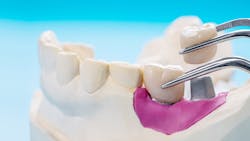Zirconia in dentistry: “It will be around for a very long time and will only get better”
Dr. Justin Chi is a laboratory technician and dentist practicing within Glidewell Dental Laboratory. I had a chance to sit down and visit with him about the evolution of zirconia in dentistry.
Joshua Austin: Dr. Chi, I believe you have a unique career path in dentistry. Can you share some details about your career and what your position is now?
Justin Chi: I had no aspirations to become a dentist growing up. After bouncing around majors in college with little direction of what I wanted to do, I decided to collaborate with my sister who was beginning her first year of dental school at USC. I didn’t really enjoy school and the sciences at the time, so I completed the three-year dental laboratory technician program. After finishing that program, I worked in various dental labs. At the end of 2007, I became a trainer for the E4D CAD/CAM system. This triggered my drive to pursue becoming a dentist. I started dental school at USC in 2011. After graduation, I was lucky enough to meet Dr. Jim Glidewell and he gave me an opportunity to join them. I am now the director of clinical technologies at Glidewell Dental Laboratory.
Also by Joshua Austin:
Talking digital workflows and 3D printing with Wade Pilling
An interview with David Fitterling of DentalMonitoring
JA: Wow, that really is a unique career. From benchtop technician to digital trainer to dentist to your current role—what a ride! What exactly does a director of clinical technologies at Glidewell do day to day and week to week?
JC: My role is a mix of patient treatment, product development, content creation for internal and external education, and providing courses and lectures. At the foundation of my work is practicing dentistry using Glidewell’s host of materials and services with a focus on chairside CAD/CAM. Through our cases, I provide feedback to the R&D team and technicians to make improvements to our existing technology and workflows. The day-to-day is ever-changing; I’m continuously shifting gears to keep up with the fast-paced environment.
At the moment, I’m in the clinic three days a week and spend the other days providing courses, facilitating webinars, or testing software. I also spend a lot of late nights doing lab work for my complex cases.
JA: What an interesting position! I am jealous of what you get to do! I want to talk with you about zirconia. Glidewell is obviously forever linked to zirconia because of the advent of BruxZir. What is the state of zirconia, as you see it? Is it still the dominant material prescribed for fixed restorations? What percentage of crowns done at Glidewell are zirconia?
JC: About 10 years ago, zirconia surpassed PFM as the most prescribed material, and its use continues to grow year after year. Today, 80% of all fixed restorations manufactured at Glidewell are zirconia. The rate of adoption has been pretty incredible. I’ll never forget what Dr. Mike DiTolla told me when I first met him seven years ago—that he’s been challenged teaching preparation techniques for various materials and indications for most of his career, and now we have a material that adapts to most preps. There are of course guidelines to optimize clinical outcomes, but we know there are no two preps or clinical situations that are identical, so having such a robust and forgiving material in our armamentarium offers dentists greater peace of mind when tackling our patients’ restorative needs.
The physical properties of zirconia are unmatched and unlike anything we’ve had in dentistry. Of all available materials, I think zirconia offers the greatest versatility with the fewest compromises. And zirconia’s main compromise of esthetics is quickly diminishing as it evolves to more translucent cubic-containing formulations along with novel characterizing techniques that allow it to rival glass ceramics in appearance. Zirconia will be around for a very long time and will only get better.
JA: That is an amazing adoption rate. Zirconia literally transformed dentistry. Is there anything about zirconia preparations that you wish every dentist knew?
JC: Every prep needs space and a clear identifiable margin. I think dentists get hung up on numbers and degrees of taper and whatnot, but the key for the lab is having enough room to put something and figuring out where the restoration attaches to the tooth. Unfortunately, there’s a lot of guesswork on the part of technicians to determine where margins are. I wish every dentist could mark their own margins so they could visualize where improvements can be made in their clinical technique.
JA: They can … with an intraoral scanner! What percentage of restorations come in from digital scanners versus analog impression material?
JC: Exactly! Digital technology can greatly improve quality of care. Glidewell is receiving 60% analog versus 40% digital impressions, which is impressive, but most labs are about 85% analog to 15% digital.
JA: Wow, we still have a long way to go on the digital front. Let’s talk about BruxZir Esthetic. What percentage of anterior units that come in to Glidewell prescribe BruxZir Esthetic?
JC: Indeed. Fortunately, more players are entering the market, which should help lower the financial barrier. BruxZir Esthetic is prescribed for 38% of the anteriors in the lab. The rest are full-strength BruxZir (27%), e.max (24%), PFM (3%), and layered zirconia (7%).
JA: Wow, that is surprising! What do you think the future of zirconia holds?
JC: Since zirconia has an intermediate stage where it’s very porous and requires an oven-sintering process, it allows for the infusion of solutions that could modify the esthetics and strength based on the indication. There are some very exciting developments for zirconia, and I think we’ve just scratched the surface.
Editor's note: This article appeared in the November 2022 print edition of Dental Economics magazine. Dentists in North America are eligible for a complimentary print subscription. Sign up here.
About the Author
Joshua Austin, DDS, MAGD
Joshua Austin, DDS, MAGD, is a graduate and former faculty member of the University of Texas Health Science Center at San Antonio School of Dentistry. Author of Dental Economics’ Pearls for Your Practice column, Dr. Austin lectures nationally on products, dental technology, online reputation management, and social media. He maintains a full-time restorative dentistry private practice in San Antonio, Texas. You may contact Dr. Austin at [email protected].
Updated June 21, 2023

